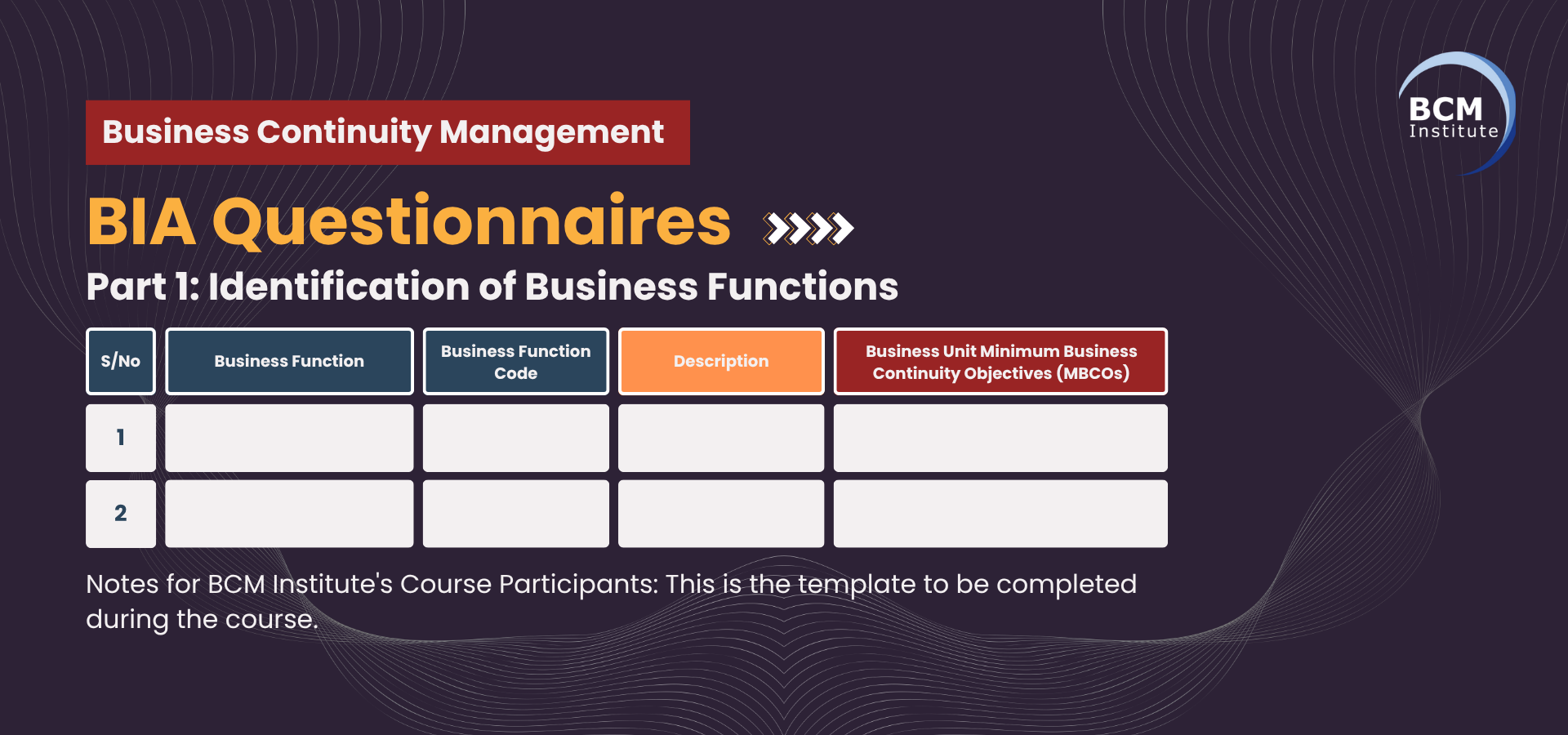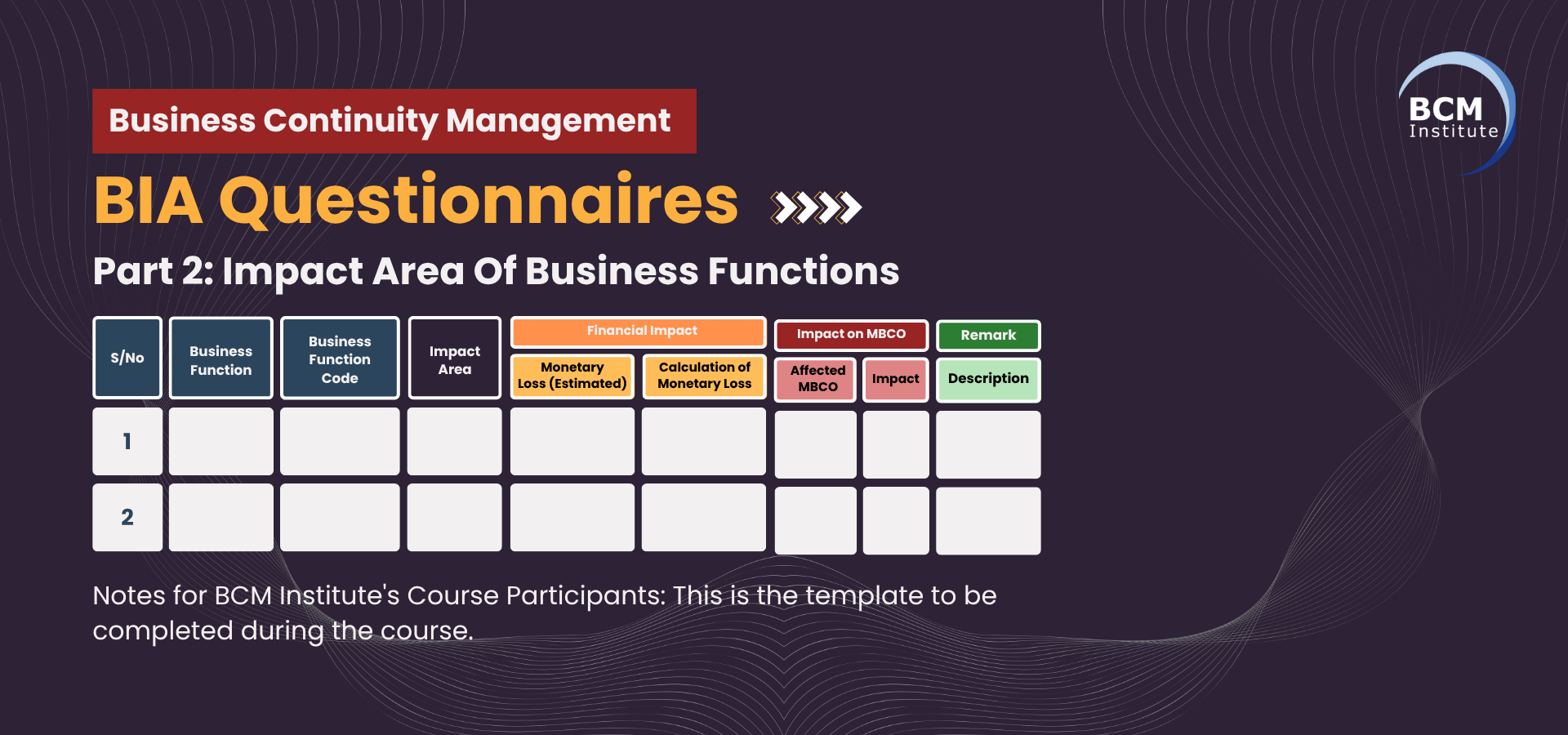[Business Impact Analysis] [Critical Business Function] [T1] Part 1

Part 1: Identification of Business Functions
CBF-6: Security & Surveillance
Security and surveillance are integral to Marina Bay Sands’ (MBS) operations, ![[BCM] [MBS] [E3] [BIA] [T1] [CBF] [6] Security & Surveillance](https://no-cache.hubspot.com/cta/default/3893111/021097cf-e5fb-47c6-beff-a5a773f222ff.png) ensuring the safety of guests, staff, assets, and critical infrastructure within one of Singapore’s most iconic integrated resorts. With its extensive hotel, casino, convention centre, shopping mall, and event venues, MBS is highly dependent on robust security and surveillance systems to mitigate risks such as theft, fraud, terrorism, crowd-related incidents, and cyber-physical threats.
ensuring the safety of guests, staff, assets, and critical infrastructure within one of Singapore’s most iconic integrated resorts. With its extensive hotel, casino, convention centre, shopping mall, and event venues, MBS is highly dependent on robust security and surveillance systems to mitigate risks such as theft, fraud, terrorism, crowd-related incidents, and cyber-physical threats.
In the context of Business Continuity Management (BCM), the identification of sub-critical business functions (Sub-CBFs) within Security & Surveillance enables MBS to define its Business Unit Minimum Business Continuity Objectives (BU MBCO). The BU MBCO reflects the minimum acceptable level of operations a business unit must sustain during a disruption to ensure corporate continuity objectives are met. This chapter outlines the ten Sub-CBFs of CBF-6, their descriptions, and the minimum operating thresholds necessary to safeguard business resilience.
Table: CBF-6 Security & Surveillance – Sub-CBFs
|
Sub-CBF Code |
Sub-CBF |
Description of CBF |
Business Unit Minimum Business Continuity Objective (MBCO) |
|
CBF-6.1 |
Access Control & Identity Management |
Management of guest, staff, vendor, and contractor access to MBS facilities through card systems, biometric checks, and visitor registration. |
Ensure at least 70% of access control systems remain operational within 4 hours to maintain secure entry points. |
|
CBF-6.2 |
Surveillance & Monitoring |
24/7 monitoring via CCTV, video analytics, and control room operations covering hotel, casino, retail, and event areas. |
Maintain 80% coverage of critical surveillance areas (casino, vaults, entrances) within 2 hours of disruption. |
|
CBF-6.3 |
Security Operations / Response |
On-ground deployment of security personnel for patrols, rapid incident response, and emergency lockdowns. |
Sustain 50% of on-site response teams during disruptions, with full capacity restored within 6 hours. |
|
CBF-6.4 |
Equipment Maintenance & Technical Surveillance Infrastructure |
Upkeep and recovery of surveillance cameras, access systems, sensors, and monitoring software. |
Ensure priority repair and redundancy systems are maintained at least 60% equipment functionality. |
|
CBF-6.5 |
Security Administration & Policy Management |
Oversight of security frameworks, policy enforcement, compliance with regulations, and security audits. |
Maintain core policy enforcement and communication channels at a minimum 50% capacity. |
|
CBF-6.6 |
Training, Drills & Human Resources Security |
Security staff training, emergency drills, and vetting/clearance of personnel. |
Continue essential staff vetting and mandatory training at reduced levels (40%) within 7 days. |
|
CBF-6.7 |
Incident Reporting & Investigation |
Recording, escalation, and investigation of security incidents to support operational continuity and legal compliance. |
Maintain the ability to log and escalate 100% of critical incidents within 1 hour. |
|
CBF-6.8 |
Event Security & Crowd Control |
Management of large-scale events, VIP protection, and visitor crowd flow within MBS venues. |
Ensure essential event security presence at 60% deployment capacity during disruptions. |
|
CBF-6.9 |
Access to External Support & Liaison |
Coordination with external agencies (police, SCDF, regulatory bodies, emergency contractors). |
Maintain 24/7 liaison capability with at least one functional communication channel. |
|
CBF-6.10 |
Security & Surveillance Business Continuity Tasks |
Execution of BCM tasks specific to security, including relocation of monitoring functions, backup operations, and crisis communication. |
Ensure a minimum 70% BCM task execution capability within 4 hours. |
Summing Up ... for Part 1
The identification of Sub-CBFs for CBF-6 Security & Surveillance at Marina Bay Sands highlights the layered and multi-dimensional nature of security operations in a large-scale integrated resort. From access control and surveillance monitoring to external liaison and incident investigation, each Sub-CBF plays a vital role in sustaining the resilience of the organisation.
By defining the Business Unit Minimum Business Continuity Objectives (MBCOs), MBS ensures that security functions continue at a minimum acceptable level during disruptions. This guarantees the protection of guests, employees, and critical assets, while maintaining regulatory compliance and stakeholder confidence. In essence, the continuity of Security & Surveillance underpins the broader resilience of MBS, supporting safe operations even under adverse conditions.
[Business Impact Analysis] [Critical Business Function] [T1] Part 2
Part 2: Impact Area Of Business Functions
CBF-6: Security & Surveillance
Security and surveillance form a critical backbone of Marina Bay Sands (MBS) operations, ensuring the safety of guests, employees, assets, and the wider reputation of the organisation. Given the complex nature of MBS as an integrated resort comprising gaming, hospitality, retail, and convention facilities, the ability to prevent, detect, and respond to security threats is vital. The business continuity implications of security-related disruptions are severe, spanning financial losses, reputational damage, regulatory penalties, and even the safety of human lives.
This section, Part 2: Impact Area of Business Functions, examines the impact of each Sub-CBF under CBF-6 Security & Surveillance. The assessment is aligned with industry practices and follows the BCM Institute methodology. Each Sub-CBF is analysed across impact areas, financial losses (with calculation methods), and its effect on the organisation’s Minimum Business Continuity Objective (MBCO). The aim is to provide management with a clear perspective on the vulnerabilities and dependencies within MBS’s security and surveillance framework.
Table: Impact Area of Business Functions – CBF-6 Security & Surveillance
|
Sub-CBF Code |
Sub-CBF |
Impact Area |
Financial Impact – Monetary Loss (Estimated) |
Financial Impact – Calculation of Monetary Loss |
Impact on MBCO – Affect MBCO |
Impact on MBCO – Impact |
Remarks – Description |
|
CBF-6.1 |
Access Control & Identity Management |
Physical Security, Compliance, Reputation |
SGD 500K – 1M |
(Avg. daily visitor revenue × % of access disruption) + fines |
Yes |
Disruption compromises controlled access to restricted zones, leading to potential security breaches |
Ensures staff, guest, and vendor authentication; failure can allow unauthorised entry. |
|
CBF-6.2 |
Surveillance & Monitoring |
Operational Integrity, Legal/Regulatory, Safety |
SGD 2M – 5M |
(Gaming revenue per day × downtime %) + potential penalties |
Yes |
Directly affects the ability to detect theft, fraud, or criminal activity |
CCTV and monitoring system downtime compromises fraud detection in gaming areas. |
|
CBF-6.3 |
Security Operations / Response |
Safety, Operational Continuity, Reputation |
SGD 1M – 3M |
(Cost of incident response + potential compensation claims) |
Yes |
Slower or absent response impacts the safety of guests/staff |
Includes patrolling, physical intervention, and coordination with emergency services. |
|
CBF-6.4 |
Equipment Maintenance & Technical Surveillance Infrastructure |
Operational Reliability, Financial, Legal |
SGD 500K – 2M |
(Replacement cost + downtime loss) |
Partial |
Failure reduces the reliability of surveillance and access control systems |
Covers CCTV systems, access card readers, scanners, alarms, and monitoring tools. |
|
CBF-6.5 |
Security Administration & Policy Management |
Compliance, Governance, Reputation |
SGD 300K – 800K |
(Regulatory fine + cost of policy revision & training) |
Yes |
Weak policies increase vulnerability and regulatory non-compliance |
Involves drafting, updating, and enforcing security SOPs. |
|
CBF-6.6 |
Training, Drills & Human Resources Security |
Safety, Preparedness, Staff Morale |
SGD 200K – 500K |
(Cost of additional training + incident escalation losses) |
Partial |
Lack of readiness leads to inefficient crisis handling |
Covers drills for fire, terror, evacuation, and HR screening protocols. |
|
CBF-6.7 |
Incident Reporting & Investigation |
Legal, Regulatory, Reputation |
SGD 500K – 1M |
(Penalty for non-reporting + litigation costs) |
Yes |
Impacts compliance reporting and legal defensibility |
Formal investigations required by regulators; lapses damage credibility. |
|
CBF-6.8 |
Event Security & Crowd Control |
Safety, Public Image, Operational Continuity |
SGD 1M – 4M |
(Event cancellation loss + liability claims) |
Yes |
High-risk during conventions, concerts, or casino events |
Mismanagement of crowds can lead to injury, panic, or public backlash. |
|
CBF-6.9 |
Access to External Support & Liaison |
Partnership Continuity, Safety |
SGD 800K – 2M |
(Cost of delayed law enforcement support + reputational loss) |
Yes |
Weak external coordination delays response to crises |
Liaison with police, SCDF, regulators, and industry security networks. |
|
CBF-6.10 |
Security & Surveillance Business Continuity Tasks |
Continuity of Operations, Recovery Speed |
SGD 1M – 3M |
(Recovery delay cost × revenue per day) |
Yes |
Failure delays restoration of critical security functions |
Involves activation of alternate monitoring systems and emergency BCP roles. |
Summing Up ... for Part 2
Security and surveillance at Marina Bay Sands represent a mission-critical business function where disruptions can quickly escalate into safety incidents, financial losses, and reputational crises.
The Sub-CBF analysis reveals that most areas significantly impact the Minimum Business Continuity Objective (MBCO) due to the integrated and high-profile nature of MBS operations.
Financially, the impact ranges from hundreds of thousands to millions of dollars per incident, driven by lost gaming revenue, regulatory fines, and liability costs.
From a business continuity management (BCM) perspective, the findings emphasise the importance of proactive security investments, robust training, and ongoing engagement with external support agencies.
Ensuring operational resilience in security and surveillance not only safeguards financial interests but also sustains customer confidence and regulatory compliance—cornerstones of Marina Bay Sands’ long-term business sustainability.
More Information About Business Continuity Management Courses
To learn more about the course and schedule, click the buttons below for the BCM-300 Business Continuity Management Implementer [BCM-3] and the BCM-5000 Business Continuity Management Expert Implementer [BCM-5].






![[BCM] [MBS] [E3] [BIA] MBCO Corporate MBCO](https://no-cache.hubspot.com/cta/default/3893111/4bf81bbc-f3de-4684-9697-f7958a5de7dd.png)
![[BCM] [MBS] [E3] [BIA] [PS] Key Product and Services](https://no-cache.hubspot.com/cta/default/3893111/a55836f0-72ae-4913-bab3-c97521678547.png)
![[BCM] [MBS] [E3] [RAR] [T1] List of Threats](https://no-cache.hubspot.com/cta/default/3893111/d14be6d3-8507-47c1-8b4e-78ba5010f775.png)
![[BCM] [MBS] [E3] [RAR] [T2] Treatment and Control](https://no-cache.hubspot.com/cta/default/3893111/fb4ef2a4-3b37-4c1b-9b02-e7305bba378c.png)
![[BCM] [MBS] [E3] [RAR] [T3] Risk Impact and Likelihood Assessment](https://no-cache.hubspot.com/cta/default/3893111/5bc50f5a-ef9d-4c82-a3da-c2b0fc407aaf.png)
![[BCM] [MBS] [E3] [BCS] [T1] Mitigation Strategies and Justification](https://no-cache.hubspot.com/cta/default/3893111/ccb9bdbb-0a81-4e2b-9b03-3b68f2801631.png)
![[BCM] [MBS] [E3] [C1] Starting Your BCM Implementation](https://no-cache.hubspot.com/cta/default/3893111/a5173a1e-de53-470b-8f64-e91260c55312.png)
![[BCM] [MBS] [E3] [BIA] [DP] [CBF] [6] Security & Surveillance](https://no-cache.hubspot.com/cta/default/3893111/43a1733b-56d5-4d83-9e78-3852406c5562.png)
![[BCM] [MBS] [E3] [BIA] [T2] [CBF] [6] Security & Surveillance](https://no-cache.hubspot.com/cta/default/3893111/6a95e794-4e20-4e8c-8241-11c32b2e2dfb.png)
![[BCM] [MBS] [E3] [BIA] [T3] [CBF] [6] Security & Surveillance](https://no-cache.hubspot.com/cta/default/3893111/b234026d-e628-4f8f-a420-a0f63c04c9ab.png)
![[BCM] [MBS] [E3] [BCS] [T3] [CBF] [6] Minimum Resources Required during a Disaster for Security & Surveillance](https://no-cache.hubspot.com/cta/default/3893111/3c449985-eaf5-4fb7-86e9-db99e22c1cb5.png)
![[BCM] [MBS] [E3] [BCS] [T3] [CBF] [6] Minimum Resources Required during a Disaster for Security & Surveillance](https://no-cache.hubspot.com/cta/default/3893111/4d716dd0-e27b-46d0-b522-18f2178a438c.png)
![[BCM] [MBS] [E3] [PD] [CBF] [6] Security & Surveillance](https://no-cache.hubspot.com/cta/default/3893111/36fb8fa1-64f8-4de4-a9d7-33a92ba0f0fe.png)


![Register [BL-B-3]*](https://no-cache.hubspot.com/cta/default/3893111/ac6cf073-4cdd-4541-91ed-889f731d5076.png)



![FAQ [BL-B-3]](https://no-cache.hubspot.com/cta/default/3893111/b3824ba1-7aa1-4eb6-bef8-94f57121c5ae.png)
![Email to Sales Team [BCM Institute]](https://no-cache.hubspot.com/cta/default/3893111/3c53daeb-2836-4843-b0e0-645baee2ab9e.png)





